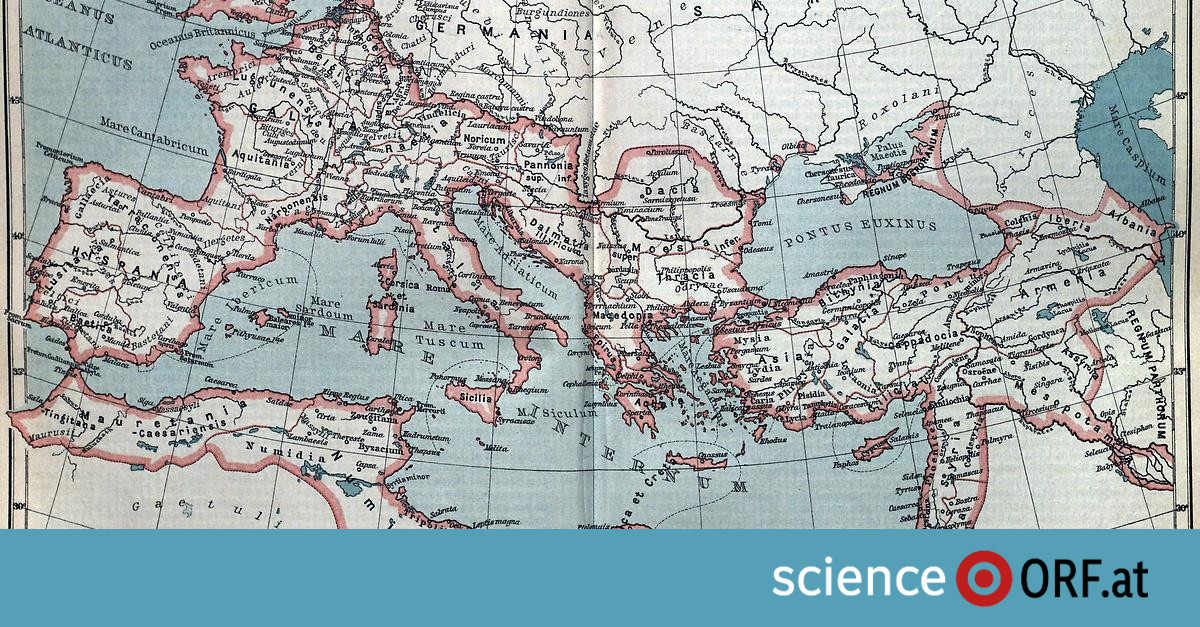Historians and climatologists have suspected for some time that there might be a link between the plague outbreak, the fall of the Roman Empire, and the climate of the time: the Roman Empire is said to have experienced its peak during a period of unusually warm weather. this Optimized for the Roman eraalso Roman warm periodIt dates from around 200 BC to 150 AD.
Cold climatic conditions from 540 AD – as The Little Ice Age in Late Antiquity – They are said to have played a major role in the fall of the Roman Empire. A research team has now examined these assumptions Karen Zonnefeld From the University of Bremen in Germany – based on sediments found on the seafloor in southern Italy. This is possible using paleoclimatological methods.
Climate archives provide data
Climate measurements using measuring instruments go back about 250 years in Europe. However, climate history before that, paleoclimate, can be reconstructed indirectly, i.e. through climate archives. These can be fossils, stalactites, tree rings – anything that contains information about past climatic conditions. For example, air bubbles trapped in Antarctic ice could be used to examine the air thousands of years ago.
The data provided by climate archives are called proxy data. As a climate archive for the current study and now In the journal “Advance Science” After its appearance, the research team used marine sediments from the Gulf of Taranto, which are the remains of fossilized plankton. Alternative data come from the cysts that make up this type of plankton – dinoflagellates.
“If you take a sediment core and slice it into small slices, you can infer from the composition of the cyst types what conditions existed in the sunlit upper waters at the time the sediment was deposited,” Zonneveld told Science.ORF.at. Through the obtained proxy data, temperature and precipitation records from the period from 200 BC to 600 AD can be reconstructed. And with one Temporal resolution From three years. In paleoclimatology, the time interval is defined between two data points that provide information about climate.
“We were able to slice the core into very small slices so that each slice represents approximately three years of sedimentary deposit,” says Zonneveld. “If you analyze the composition of the cysts, you can reconstruct the average temperatures in southern Italy in late summer and fall during these “The three years.”
Three outbreaks of plague during the cold period
Using this data, the researchers were able to observe how the climate in the Roman Empire evolved over 800 years: starting around AD 130, temperatures and precipitation became increasingly variable. Cold periods signal the end Roman warm period They coincide with historical epidemics: the Antonine Plague (ca. 165 to 180 AD) and the Cyprus Plague (ca. 251 to 266 AD).
But the most devastating was the Plague of Justinian, which broke out around 540 AD. Using alternative data, the research team found that there was a sharp drop in temperature between 537 and 590 degrees, which was about three degrees cooler than the warmest periods of the Roman Warm Period.
“The first pandemic occurred when the climate became colder and began to fluctuate outside the range of relatively small climate changes that had occurred in previous centuries. Both the second and third pandemics coincide with a further shift to a cooler period and even colder temperatures,” Zonneveld said.
Did cold lead to the fall of the Roman Empire?
But why do epidemics break out during cold spells? “We know that ancient Rome was an agricultural society: in Italy, wheat, wine and oil formed the basis of the economy. Along with the Nile Valley, Italy was also the most densely populated part of the Roman Empire. We also know that climate is an important factor influencing fundamental aspects affecting Human well-being, such as agriculture, biodiversity, geographical distribution and migration of species.
Which of these factors or which combination of factors caused or intensified the epidemics cannot be determined by the current study, but further research is needed. However, the results confirm the relationship between climate fluctuations and the occurrence of epidemics.
According to Zonnefeld in the interview, it is “very difficult” to answer whether the cold periods from 130 AD onwards were actually decisive in the fall of the Roman Empire: “But we see that the times when the Roman Empire expanded correspond to those times.” Our records show relatively stable climatic conditions. However, times of social instability and unrest coincide with times when the climate has become extremely unstable.
Learn from historical examples
But the research team was not only interested in the effects of natural climate change on people in the Roman Empire, but also – given the coronavirus pandemic – in the general links between climate and infectious disease dynamics. Modern societies have very different resources than humans in ancient times, such as productive agriculture, global trade networks, and medical and scientific resources, but the coronavirus pandemic has demonstrated the risks that still accompany infectious diseases, according to the study authors.
Climate, then as it is now, “was an important factor influencing fundamental aspects that affect our well-being: agriculture, access to clean water, biodiversity, geographic distribution, and migration of species, including pathogens,” Zonneveld said. Examples from history can help to better understand these complex connections.

“Food practitioner. Bacon guru. Infuriatingly humble zombie enthusiast. Total student.”







More Stories
KaDeWe stops selling meat and sausages
Another earthquake near the giant Naples volcano
Trump wants to block Harris' access to donations